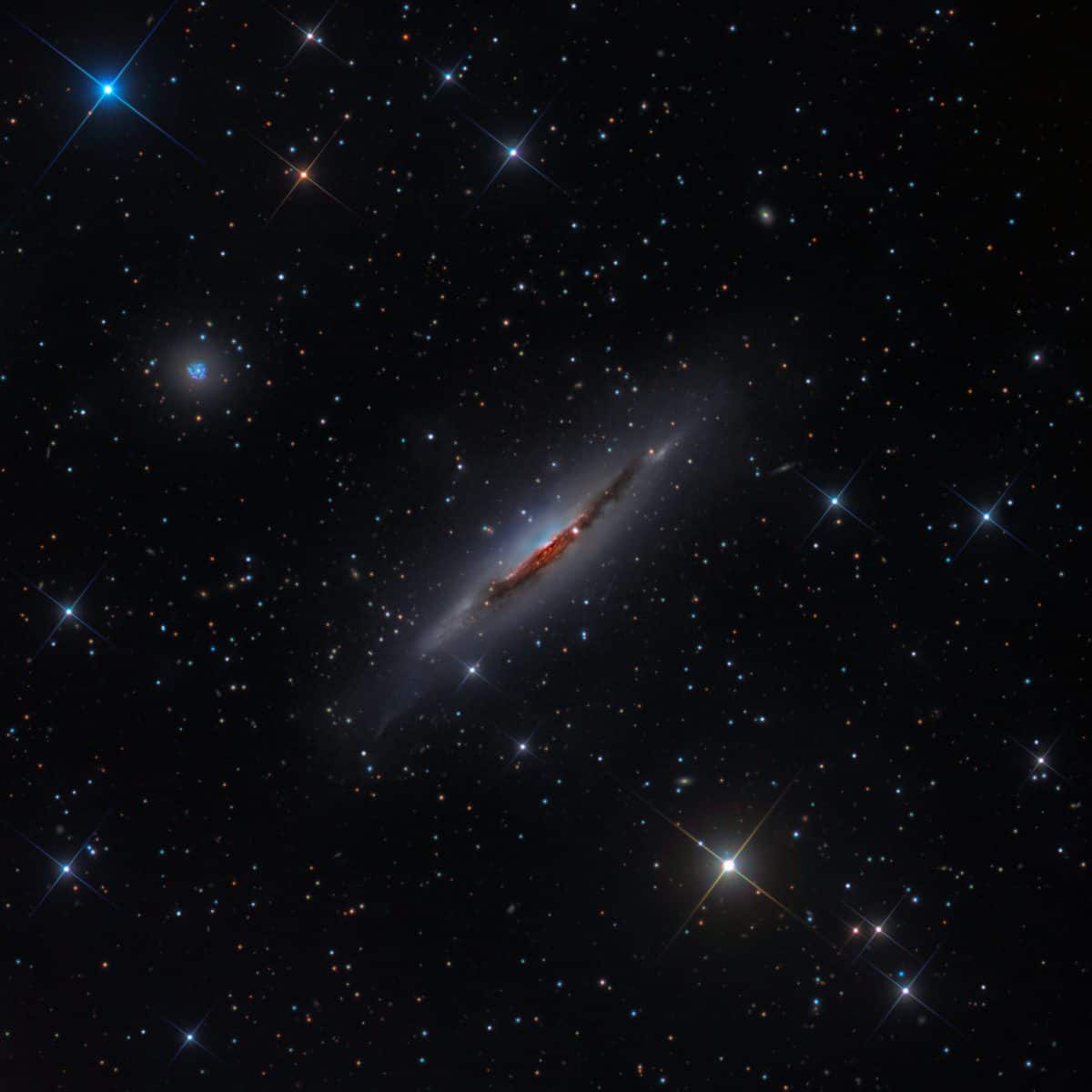Blog
Barney Kessel (October 17, 1923 – May 6, 2004) was an American jazz guitarist born in Muskogee, Oklahoma. Noted in particular for his knowledge of chords and inversions and chord-based melodies, he was a member of many prominent jazz groups as well as a “first call” guitarist for studio, film, and television recording sessions. Kessel was a member of the group of session musicians informally known as the Wrecking Crew.
Kessel began his career as a teenager touring with local dance bands. When he was 16, he started playing with the Oklahoma A & M band, “Hal Price & the Varsitonians”. The band members lovingly nicknamed him “Fruitcake” because he used to practice up to 16 hours a day. He then moved on to bands such as that led by Chico Marx. He quickly established himself as a key post-Charlie Christian jazz guitarist.
In 1944 he participated in the film Jammin’ the Blues, which featured Lester Young, and in 1947 he recorded with Charlie Parker‘s New Stars on the Relaxin’ at Camarillo session for Dial Records.[1] He was rated the No. 1 guitarist in Esquire, Down Beat, and Playboy magazine polls between 1947 and 1960.
more...William Randolph “Cozy” Cole (October 17, 1909 – January 9, 1981) was an American jazz drummer who had hits with the songs “Topsy I” and “Topsy II“. “Topsy II” peaked at No. 3 on the Billboard Hot 100, and at No. 1 on the R&B chart. It sold over one million copies and was awarded a gold disc. The track peaked at No. 29 in the UK Singles Chart in 1958. The recording contained a long drum solo and was one of the few drum solo recordings to make the charts at Billboard magazine. The single was issued by Love Records, a small record label in Brooklyn, New York. Cole’s song “Turvy II” reached No. 36 in 1959.
William Randolph Cole was born in 1909 in East Orange, New Jersey. His first music job was with Wilbur Sweatman in 1928. In 1930 he played for Jelly Roll Morton‘s Red Hot Peppers, recording an early drum solo on “Load of Cole”. He spent 1931–33 with Blanche Calloway, 1933–34 with Benny Carter, 1935–36 with Willie Bryant, 1936–38 with Stuff Smith‘s small combo, and 1938–42 with Cab Calloway. In 1942, he was hired by CBS Radio music director Raymond Scott as part of network radio’s first mixed-race orchestra. After that he played with Louis Armstrong’s All Stars.
Cole appeared in music-related films, including a brief cameo in Don’t Knock the Rock. Throughout the 1960s and 1970s he continued to perform in a variety of settings. Cole and Gene Krupa often played drum duets at the Metropole in New York City during the 1950s and 1960s.
Cole is cited as an influence by many contemporary rock drummers, including Cozy Powell, who took his nickname “Cozy” from Cole. In 1981, he died of cancer in Columbus, Ohio.
more...https://www.youtube.com/watch?v=C2Mei2-Nldc
more...Spiral Galaxy in Hydra (NGC 3717) NGC 3717 is visible as nearly edge-on galaxy showing a distinct dust band in the constellation Hydra. It is about 80 million light years away from the solar system, and it extends 3.5 arc-min in the sky.
Surprisingly the galaxy features some faint extension to the south (star stream), an indication of possible tidal interaction with another galaxy.
At 7h to the south there is another adjacent galaxy (IC 2913) showing spiral arms and H-alpha areas Its redshift indicates a similar distance of 77 million light-years to earth.
more...Roy Anthony Hargrove (born October 16, 1969) is an American jazz trumpeter. He won worldwide notice after winning two Grammy Awards for differing types of music, in 1997 and in 2002. Hargrove has played primarily with jazz musicians including Wynton Marsalis and Herbie Hancock.
Hargrove was the bandleader of the progressive group The RH Factor, which combined elements of jazz, funk, hip-hop, soul, and gospel music. Its members have included Chalmers “Spanky” Alford, Pino Palladino, James Poyser, Jonathan Batiste and Bernard Wright.
more...Joseph Lee “Big Joe” Williams (October 16, 1903 – December 17, 1982) was an American Delta blues guitarist, singer and songwriter, notable for the distinctive sound of his nine-string guitar. Performing over four decades, he recorded the songs “Baby Please Don’t Go”, “Crawlin’ King Snake” and “Peach Orchard Mama”, among many others, for various record labels, including Bluebird, Delmark, Okeh, Prestige and Vocalion. He was inducted into the Blues Hall of Fame on October 4, 1992.
The blues historian Barry Lee Pearson (Sounds Good to Me: The Bluesman’s Story, Virginia Piedmont Blues) described Williams’s performance:
- When I saw him playing at Mike Bloomfield’s “blues night” at the Fickle Pickle, Williams was playing an electric nine-string guitar through a small ramshackle amp with a pie plate nailed to it and a beer can dangling against that. When he played, everything rattled but Big Joe himself. The total effect of this incredible apparatus produced the most buzzing, sizzling, African-sounding music I have ever heard.
Born in Oktibbeha County, a few miles west of Crawford, Mississippi, Williams as a youth began wandering across the United States busking and playing in stores, bars, alleys and work camps. In the early 1920s he worked in the Rabbit Foot Minstrels revue. He recorded with the Birmingham Jug Band in 1930 for Okeh Records.
https://www.youtube.com/watch?v=U6RNptsBorM
more...From afar, the whole thing looks like an Eagle. A closer look at the Eagle Nebula, however, shows the bright region is actually a window into the center of a larger dark shell of dust. Through this window, a brightly-lit workshop appears where a whole open cluster of stars is being formed. In this cavity tall pillars and round globules of dark dust and cold molecular gas remain where stars are still forming. Already visible are several young bright blue stars whose light and winds are burning away and pushing back the remaining filaments and walls of gas and dust. The Eagle emission nebula, tagged M16, lies about 6500 light years away, spans about 20 light-years, and is visible with binoculars toward the constellation of the Serpent (Serpens). This picture involved over 25 hours of imaging and combines three specific emitted colors emitted by sulfur (colored as red), hydrogen (yellow), and oxygen (blue).
more...Fela Anikulapo Kuti (15 October 1938 – 2 August 1997), also professionally known as Fela Kuti, or simply Fela, was a Nigerian multi-instrumentalist, musician, composer, pioneer of the Afrobeat music genre and human rights activist. He has been called “superstar, singer, musician, Panafricanist, polygamist, mystic, legend.” At the height of his popularity, he was referred to as one of Africa’s most “challenging and charismatic music performers.”
Fela was born Olufela Olusegun Oludotun Ransome-Kuti on 15 October 1938 in Abeokuta, the modern-day capital of Ogun State in the Federal Republic of Nigeria, then a city in the British Colony of Nigeriainto an upper-middle-class family. His mother, Chief Funmilayo Ransome-Kuti, was a feminist activist in the anti-colonial movement; his father, Reverend Israel Oludotun Ransome-Kuti, an Anglican minister and school principal, was the first president of the Nigeria Union of Teachers. His brothers, Beko Ransome-Kuti and Olikoye Ransome-Kuti, both medical doctors, are well known in Nigeria. Fela is a first cousin to the Nigerian writer and Nobel laureate Wole Soyinka, the first African to win the Nobel Prize for Literature.
more...Lionel Frederick Cole (born October 15, 1931) is an American jazz singer and pianist whose recording career has spanned over sixty-five years. He is the brother of musicians Nat King Cole and Ike Cole, father of Lionel Cole, and uncle of Natalie Cole, Carole Cole, Timolin Cole, and Casey Cole.
Cole was born to Edward and Paulina Cole, and grew up in Chicago with siblings Eddie, Ike and Nat King Cole. He began playing piano at the age of six, and continued his musical education at the Roosevelt Institute in Chicago. He moved to New York in 1951, where he studied at the Juilliard School of Music, before completing a master’s degree at the New England Conservatory of Music.
Following the moderate success of “Whispering Grass” on OKeh Records in 1953 Cole spent several months on the road with Johnny Coles and Benny Golson as the Earl Bostic band. During the 1970s, Cole recorded several albums for European and English based labels. He went on to work with Grover Washington, Jr. and to record jingles for various companies, including Turner Classic Movies He was the subject of the 2006 documentary The Cole Nobody Knows. In June of that year, Cole was added to the Steinway Artist roster.
https://www.youtube.com/watch?v=qZTW_UBdNn4
more...Nellie Rose Lutcher (October 15, 1912 – June 8, 2007) was an African-American R&B and jazz singer and pianist, who gained prominence in the late 1940s and early 1950s. Lutcher was most recognizable for her diction and exaggerated pronunciation, and was credited as an influence by Nina Simone among others.
Lutcher was born in Lake Charles, Louisiana, the eldest daughter of the 15 children of Isaac and Suzie Lutcher. She was the sister of saxophonistJoe Lutcher. Her father was a bass player and her mother a church organist. She received piano lessons, and her father formed a family band with her playing piano. At age 12, she played with Ma Rainey, when Rainey’s regular pianist fell ill and had to be left behind in the previous town. Searching for a temporary replacement in Lake Charles, one of the neighbors told Rainey that there was a little girl who played in church who might be able to do it.
Aged 15, Lutcher joined her father in Clarence Hart‘s Imperial Jazz Band, and in her mid-teens also briefly married the band’s trumpet player. In 1933, she joined the Southern Rhythm Boys, writing their arrangements and touring widely. In 1935, she moved to Los Angeles, where she married Leonel Lewis and had a son. She began to play swing piano, and also to sing, in small combos throughout the area, and began developing her own style, influenced by Earl Hines, Duke Ellington and her friend Nat “King” Cole.
She was not widely known until 1947 when she learned of the March of Dimes talent show at Hollywood High School, and performed. The show was broadcast on the radio and her performance caught the ear of Dave Dexter, a scout for Capitol Records. She was signed by Capitol and made several records, including “The One I Love (Belongs to Somebody Else)” and her first hit single, the risqué “Hurry On Down”, which went to # 2 on the rhythm and blues chart. This was followed by her equally successful composition “He’s A Real Gone Guy”, which also made # 2 on the R&B chart and crossed over to the pop charts where it reached # 15.
more...When did Orion become so flashy? This colorful rendition of part of the constellation of Orion comes from red light emitted by hydrogen and sulfur (SII), and blue-green light emitted by oxygen (OIII). Hues on the featured image were then digitally reassigned to be indicative of their elemental origins — but also striking to the human eye. The breathtaking composite was painstakingly composed from hundreds of images which took nearly 200 hours to collect. Pictured, Barnard’s Loop, across the image bottom, appears to cradle interstellar constructs including the intricate Orion Nebula seen just right of center. The Flame Nebula can also be quickly located, but it takes a careful eye to identify the slight indentation of the dark Horsehead Nebula. As to Orion’s flashiness — a leading explanation for the origin of Barnard’s Loop is a supernova blast that occurred about two million years ago.
The Orion Nebula (also known as Messier 42, M42, or NGC 1976) is a diffuse nebula situated in the Milky Way, being south of Orion’s Belt in the constellation of Orion. It is one of the brightest nebulae, and is visible to the naked eye in the night sky. M42 is located at a distance of 1,344 ± 20 light years and is the closest region of massive star formation to Earth. The M42 nebula is estimated to be 24 light years across. It has a mass of about 2,000 times that of the Sun. Older texts frequently refer to the Orion Nebula as the Great Nebula in Orion or the Great Orion Nebula.
more...Justin David Hayward (born 14 October 1946) is an English musician best known as songwriter, lead singer, and guitarist for the rock band the Moody Blues. In 2018, Hayward was inducted into the Rock and Roll Hall of Fame alongside the Moody Blues.
In 1966, after answering another ad in Melody Maker, this time placed by Eric Burdon of The Animals, Hayward was contacted by Mike Pinder of the Moody Blues after Burdon had passed on Hayward’s letter and demo discs to Pinder. Within a few days, Hayward had replaced departing Moody Blues vocalist and guitarist Denny Laine. Bassist John Lodge replaced temporary deputy Rod Clarke, who had stood in for departed bassist Clint Warwick at the same time.
more...Jewell Stovall, better known as Babe Stovall (October 14, 1907 – September 21, 1974), was an American Delta blues singer and guitarist.
Stovall was born in Tylertown, Mississippi, United States, in 1907, the youngest of eleven children (thus his nickname “Babe”). He learned to play the guitar by the age of eight, and his guitar playing style was influenced by Tommy Johnson, whom he had met in Mississippi around 1930. In 1964, he relocated to New Orleans, Louisiana, where he entertained on the streets, and in cafes and galleries of the French Quarter. Stovall frequently took young white musicians under his wing as apprentice performers, teaching them traditional country blues songs and guitar techniques. He variously played his guitar at the back of his neck, and hollered his song lyrics loudly for all in the vicinity to hear. In 1964 he recorded an album for Verve, titled Babe Stovall (which was re-released in 1990 on CD), and undertook more recordings in 1966, released as The Babe Stovall Story. His later work with Bob West resulted in The Old Ace: Mississippi Blues & Religious Songs, which was released on Arcola (2003). He was credited by some as the character inspiration behind Jerry Jeff Walker‘s, “Mr. Bojangles”.
Stovall played on the college circuit, in addition to being the regular musician at the Dream Castel Bar on Frenchman Street,[2] and The Quarum club in New Orleans.
more...More Posts
- World Music with Paco de Lucía & Ricardo Modrego
- Daily Roots with Prince Buster
- The Cosmos with NGC 6744
- Naná Vasconcelos Day
- Carl Saunders Day
- World Music with Faenza Codex
- Daily Roots with Earl Sixteen
- Jerry Garcia Day
- The Cosmos with M66
- Robert Cray Day
- Jerry Garcia Day
- World Music with Mai Tuyet Hoa
- Daily Roots with Horace Andy, Rod Taylor, Earl Sixteen
- The Cosmos with Melotte 15
- Stanley Jordan Day
- Kenny Burrell Day
- Hank Jones Day
- World Music with John Dowland
- Daily Roots with Rod Taylor
- The Cosmos with NGC 3368


